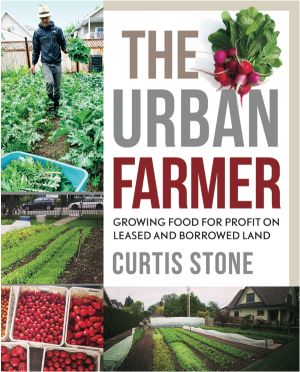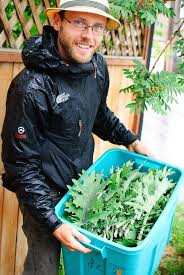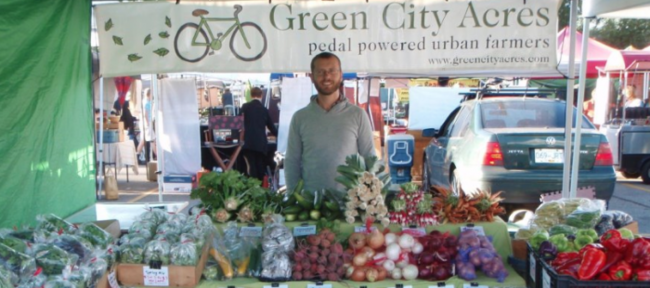14 Jan 2016
Book Review: ‘The Urban Farmer’ by Curtis Stone.

Book Review: The Urban Farmer: growing food for profit on leased and borrowed land. Curtis Stone. New Society Publishers (266pp).
In my visits to meet different Transition groups, I get to see lots of community gardens. Community gardens can be amazing spaces, places for communities to come together, to run events, to learn new skills, to taste good food and to see it growing. They clearly grow much more than just food. But what might it look like if they were also designed to maximise the productive use and economic potential of the space available? If the intention was to create as much employment as possible, how different would they be? If they were reimagined to act as a spark for an entrepreneurial, REconomy-based approach?
We could allow ourselves to dream how it might be if that approach extended beyond community gardens, and large swathes of land in our towns and cities hosted beautiful, diverse, abundant gardens growing good food and viable incomes. Curtis Stone’s brilliant new book ‘The Urban Farmer’, is one of the most important contributions to Transition thinking over the last 10 years, and sets out in great depth and detail what that could look like. And he knows because he’s done it. Here’s the promotional video for the book which gives you a sense of it:
The Urban Farmer is simultaneously deeply visionary and immensely practical, always a heady brew. “What if we could repurpose the suburbs to be the new frontier of localisation?” writes Stone. “What if all of these new suburban streets turned into areas for transition, reeducation and abundance? I believe this is not only a possibility but an inevitability”.
As he points out, there is nothing new about growing food in cities, and nothing new about doing so commercially. For example, Paris was home to incredibly sophisticated fruit growing systems, and to market gardens who pioneered a system now referred to as “French Intensive”, which, until the 1920s, covered 6% of the land within the city limits. As Eliot Coleman put it in “The Winter Harvest Handbook”:
“The Paris market garden of the nineteenth century measured on average 4000-8000 m2. A master gardener gave this advice: “Always choose the smallest plot of land as possible, but grow it exceptionally well.” Another market gardener of the time described their profession as “the goldsmiths of the ground.””
Well, that advice is much the same as Stone would give today. Growing food in cities, in many ways, makes more sense than growing it on a farm. You are closer to your market, and have the opportunity to build a closer relationship to them, your start-up and overhead costs are lower, you have better growing conditions with more favourable microclimates, less pests and weeds, better access to water. ‘The Urban Farmer’ takes you through everything you could want to know about becoming an urban farmer.
“It is important”, he writes, “to understand that urban farmers cannot and should not try to grow everything”. There is no point, for example, growing grains, or potatoes: it makes far more sense to focus on short greens with short shelf lives, which don’t benefit from long distance travel, or which have a high yield per square foot. So Stone sets out in the book how to find suitable sites (private gardens, waste land, Council land), suggesting that poring over Google maps of the place you live might be a good place to start. He takes you through how to get the soil checked, start a business, develop your business plan and marketing, how to design your site for maximum output, what tools you’ll need, how to extend the season at low cost, what crops to grow, how to harvest and different models for selling.

Perhaps the most inspiring, and powerful, part of the book is his “start-up farm models”. Here he sets out 5 different business models on different scales, what kind of initial investment you’d need and what kinds of return you might expect. You could start on a quarter of an acre or smaller, or go a bit bigger. For each he sets out the kinds of crops that could work well, and the kinds of profits you might expect.
He captures a spirit emerging in all kinds of different settings. The craft brewing movement takes a similar approach, as Tony Naylor argues in a recent article in The Guardian:
“Rather than international craft brands, I would argue that what beer needs is more small local breweries, for both practical and ideological reasons. Beer begins to deteriorate as soon as it is shipped from the brewery, so drinking fresh, local beer is the ideal“.
Scaling up the approach Stone sets out here has the potential to reimagine our towns and cities. We can get a sense of what that might look like by looking to Tordmorden, to Detroit, and to other places, as the film ‘Demain‘ so beautifully captures. An economy that values taste, innovation, relationship, place, is already here, and is growing fast.
One of my dreams when we started the Transition movement was that we might reach a point where urban market gardeners, people growing mushrooms in old office blocks, craft brewers, people baking amazing bread in old industrial units, would be the coolest people around. Young people would yearn to emulate them. At the end of the book he writes:
“Let’s live a new definition of what it means to be a farmer: one who is at the root of the community by serving the needs of those in it. Farmers connect people to where their food comes from and empower others to start growing food themselves. Farmers can turn derelict areas into beautiful and productive farms that are flagship examples of local food resilience”
I was sent an early version of this book, and wrote an endorsement for the cover. I wrote:
“If I were 18 again and given this book, it would put a fire in my belly and set me on a career path that is cutting edge, deeply entrepreneurial and profoundly responsible. The Urban Farmer deserves to be a best-seller”.
Read it, and dream small (in a good way). Vital stuff.
More information, and order your copy here.
